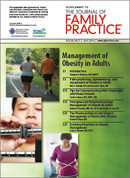User login
More than one-third of adults and one-sixth of children and adolescents in the United States are obese (ie, body mass index [BMI] ≥30 kg/m2).1 This is more than double the prevalence in 1994).2 Also of great concern, is that the prevalence of extreme obesity (BMI ≥40 kg/m2) rose from 3.9% to 6.6% in the United States from 2000 to 2010, a 70% increase.3 As primary care providers, family physicians contend on a daily basis with cardiovascular and other health consequences of this burgeoning epidemic.
More than one-third of adults and one-sixth of children and adolescents in the United States are obese (ie, body mass index [BMI] ≥30 kg/m2).1 This is more than double the prevalence in 1994).2 Also of great concern, is that the prevalence of extreme obesity (BMI ≥40 kg/m2) rose from 3.9% to 6.6% in the United States from 2000 to 2010, a 70% increase.3 As primary care providers, family physicians contend on a daily basis with cardiovascular and other health consequences of this burgeoning epidemic.
More than one-third of adults and one-sixth of children and adolescents in the United States are obese (ie, body mass index [BMI] ≥30 kg/m2).1 This is more than double the prevalence in 1994).2 Also of great concern, is that the prevalence of extreme obesity (BMI ≥40 kg/m2) rose from 3.9% to 6.6% in the United States from 2000 to 2010, a 70% increase.3 As primary care providers, family physicians contend on a daily basis with cardiovascular and other health consequences of this burgeoning epidemic.
